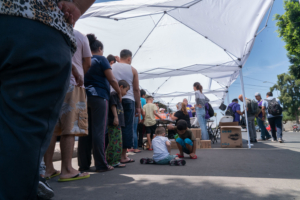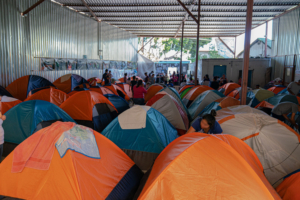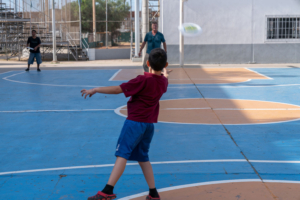Movimiento Juventud 2000

About Movimiento Juventud 2000
Movimiento Juventud 2000 was the first of the albergues we visited, back in August 2019, and we have been back a number of times since. It is located close to El Centro and close to the border (you could huck an aerobie from there to the border fence, but you probably shouldn’t) inside a warehouse constructed with a gap under the corrugated steel roof, to allow plenty of air in. We found out about Movi Juventud 2000 thanks to a connection with a delegation of SEIU 721 healthcare workers who regularly head down from Los Angeles to provide pop-up clinics for the migrants in the albergues.
When we were first there, there were about 40 families present, living in tightly packed rows of tents on a concrete floor. Since the surrounding neighborhood is not safe, the kids can only go out with their parents, and then fairly infrequently. While inside they don’t have a lot of space, so they play games that don’t require much, like Pogs.
We got the idea while visiting that it would be great to give out ARIA discs (which we had with us for giving out, thanks to our Ultimate Everywhere collaboration with ARIA), and to take the kids, with their parents, to a nearby park to do some throwing.
While at Movimiento Juventud we learned a lot about the process that the migrants go through. When they arrive in the Tijuana area, they either present themselves to or are picked up by the authorities. They receive a number, which establishes their place “in line” for an initial asylum hearing in the US (the “credible fear” interview). Under the provisions of the so-called Migrant Protection Protocols (MPP), they wait in Mexico for their number to come up for what will be the first of several asylum hearings that they will have to navigate. Many wait in one of the 32 albergues (refugee hostels) of Tijuana, about half of which are “officially recognized” by the government, though they do not receive government funded. Instead, like Movimiento Juventud 2000, each is a privately funded organization, relying on donations and aid from various civic organizations, such as local churches and others.






After teaching the kids the basics of throwing, we had the chance to interview some of the parents about their experiences, while the kids kept playing (it was sustained, delightful chaos, with discs flying everywhere for about an hour). The stories, like so many we heard in the course of subsequent trips, were harrowing. Most disturbing of all were the repeated tales of the “hieleras”, or iceboxes. Very often, following an initial hearing, the migrants may be kept for some time in detention in US facilities before being returned to Mexico.
At the detention facilities it is common for migrants to be kept in rooms with concrete floors that are kept cold (60°F or less) with only a mylar blanket to keep warm, with the lights on 24 hours a day. Legally they can be kept no longer than 72 hours, but we were told that many were kept much longer than this. Out of concern about this physical and psychological stress to which migrants engaging a legally established procedure for applying for asylum are being systematically exposed, we later met with staff of congressman Ted Lieu (D-CA), who has been active in trying to address the problem. We were told that in a hearing with Immigrations and Customs Enforcement (ICE) officials, the congressman was told that ICE did this to “discourage them from coming.”
Here is an interview (in Spanish) with a Honduran migrant, Oscar, who tells the story of his confinement in the hielera with his son, to whom he gave his coat to prevent his son from getting sick, and as a result he himself got ill from the sustained cold exposure.
Oscar – un migrante que viene de Honduras, describiendo su experiencia con su hijo en la hielera
The following interview (also in Spanish), is with José Ma. García Lara, aka Chema, the founder and director of Movimiento Juventud 2000. He discusses the history of the shelter, and the challenges of caring for migrants, and the challenges that they face in their journey.
José Ma. Garcia Lara (Chema), el Director del albergue Movimiento Juventud 2000, hablando sobre la situación que enfrentan los migrantes que intentan recibir asilo.
We have gone back to Movimiento Juventud 2000 a number of times, and look forward to working with our partners in Tijuana to help provide recreational opportunities for and discs to the children there, along with training in how to throw and play ultimate. We hope you’ll consider donating, and thank you!




































































